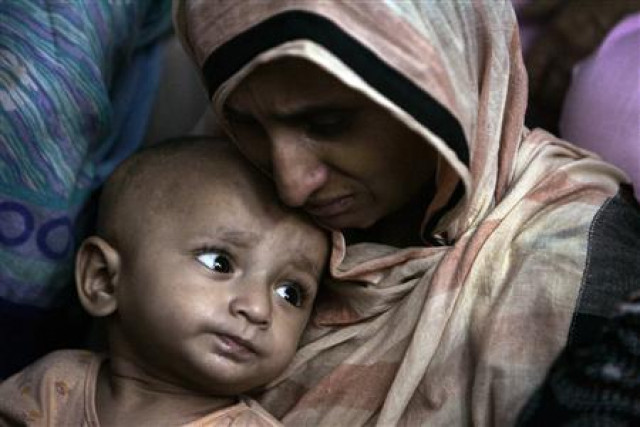Pneumococcal disease: Taming the top child killer
The leading cause of death among children under five years is preventable.

Your child is cranky, irritable, running a high fever and sniffling – all signs lead to them having a cold. Add to that rapid breathing and difficulty in inhalation and experts will tell you that your child is in fact suffering from what is called Pneumococcal Disease (PD).
PD is the number one killer among children under five years of age throughout the world.
In Asia, approximately one child dies every two minutes from PD, and Pakistan ranks among the top five countries contributing towards the disease burden.
Here’s the math: Throughout the world around 800,000 children, under the age of five, die each year due to this disease. Pakistan’s five per cent contribution means approximately 40,000 children in the country, below five years of age, suffer from this fatal infection.
To date, approximately 84,000 children in Pakistan have died as a result of PD.
South Asia reports the highest number of PD cases, 5,480,000, for children below five years, while deaths resulting from PD amount to 187,000 for the same region. “It is a human tragedy,” said Dr Musa Mohammad Nordin, a leading Malaysian paediatrician. PD can be invasive which means if the infection passes through the child’s brain, it can lead to meningitis, and if it passes through the lungs, it can cause severe pneumonia.
What makes these facts and figures even more disturbing is that PD is a vaccine-preventable disease.
Following the introduction of the first pneumococcal conjugate vaccine (PCV) ten years ago, leading global public health experts gathered in Kuala Lumpur on June 18-19 for the Asia Pneumococcal Disease Conference organised by Pfizer in collaboration with the Malaysian Pediatric Association.
For developing countries such as Pakistan, where PCVs are not routinely used, it is not uncommon for doctors to come across infants and children suffering from pneumococcal bacteremia, meningitis and pneumonia. It is also not uncommon for physicians to err on the side of diagnosing or even aggressively treating any potential case of PD.
“However, with the introduction of the 7-valent first generation pneumococcal conjugate vaccine (PCV 7) a decade ago, all of that changed. PCV 7 exceeded all expectations, making extraordinary public health contributions in countries where it is included as part of the national immunisation programme,” said Dr Bernard Fritzell, the vice president of the International Scientific & Clinical Affairs, Pfizer vaccines.
However, with the changing face of PD, certain strains of pneumococcal bacteria not included in the first generation vaccine have increased in prevalence and are frequently resistant to antibiotics, said Dr Fritzell, adding that in order to counter this epidemiologic shift, Pfizer introduced PCV 13 to help provide coverage against even more disease-causing serotypes threatening children throughout the world today.
Following the development of PCV 13, real-world data is beginning to emerge, showing a notable trend towards reduction in invasive PD.
“Many a time, despite being diagnosed, the disease isn’t treated effectively. This is usually because the infection spreads so rapidly that there isn’t enough time for antibiotics to work properly which is why any health expert will tell you: prevention is always better than cure,” said Dr Sajid Maqbool, Pakistan’s leading paediatrician who was also speaking at the conference.
According to Dr Maqbool, PCV 13 is taking time to catch on in a country such as Pakistan because medical practitioners and parents are still largely unaware of the existence of this deadly disease, and he also believes the affordability factor plays a huge role.
“Pakistan is a GAVI-recognised country and we are working towards the inclusion of PCV 13 in Pakistan’s Expanded Programme on Immunisation (EPI) which would allow the public free access to the vaccine,” said Dr Maqbool.
When asked if the inclusion of PCV would make a significant difference in the number of PD cases, considering the numerous obstacles still facing Pakistan’s annual anti-polio drives, Dr Maqbool said: “There’s a difference; PCV should succeed because of four reasons: a) Once it’s made part of the EPI it will be provided free of cost; b) The polio vaccine has to be refrigerated at a particular temperature, failing which could cause the vaccine to become ineffective, whereas while PCV13 does require to be refrigerated as well, it may not require as stringent a cold chain as the polio vaccine; c) Polio vaccination requires oral intake and many a time children just spit it right out, whereas PCV is injected into the child and d) With PCV 13, just three doses should be more than effective.”
PCV 13 also prevents a child against meningitis, blood poisoning and ear infection, while the immunisation benefit is also passed on to other children and elders within the family through various forms of physical contact, also known as herd immunity, said Dr Maqbool.
This is especially beneficial for older people who become prone to PD as their immune system begins to weaken with age. “The immunisation is cost-effective and should definitely be made part of the government’s healthcare scheme.”
Published in The Express Tribune, June 22nd, 2011.



















COMMENTS
Comments are moderated and generally will be posted if they are on-topic and not abusive.
For more information, please see our Comments FAQ